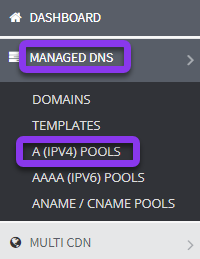
Knowledge Base
Create an A Record Pool
Overview
One of the most common load balancing techniques is a Round Robin configuration that utilizes DNS record pools. This tutorial will explain how to create pools for A records, which are used to balance traffic across multiple IPv4 addresses. Traffic can be distributed evenly (standard Round Robin) or based on the performance or capacity of the systems in the pool (Weighted Round Robin).
Common Use Cases for A Record Pools
If you want to distribute traffic across multiple servers using a regular or Weighted Round Robin configuration, you can add multiple IPv4 addresses to a pool and then apply them to the same record.
You can also create a failover record pool using A records. This technique works similarly to Round Robin except that with a failover pool, your traffic will only be sent to healthy resources in the pool. For instance, if you have your A record pointed to three different IPs, and one of them is unavailable, the downed IP will not be returned.
To learn more about load balancing, use cases, and to view video tutorials visit our DNS Load Balancing page.
Prerequisites
- A domain has already been added to your Contellix account
- You understand the basics of load balancing
- Records have been created or imported for your domain
Note: We have several tutorials on creating records if you need help.
Configure A (IPv4) Record Pools in Constellix
- Click Managed DNS and Select Pool
Once logged into Constellix, select Managed DNS in the left-hand sidebar menu. This will display a drop-down list of DNS configuration options. Next, select A (IPv4) Pools from the drop-down menu.

- Click Add New Pool
Next, select the green + Add New Pool button on the right-hand side of the screen.

- Enter Values
The Add Pool A pop-up window will display. Add the information for your pool by following the steps below:

A. Name: Give your pool configuration an identifiable name.
B. Num Return: Specify the number of IPs you want to have returned in the pool.
C. Min Available: Enter the minimum number of IPs that must be available in the pool.
D. Enable ITO: For more information on ITO, click here.
E. Contact Notify: This option allows you to select a contact list to send notifications to. For help setting up a contact list, go here.

F. IP: Enter the IPv4 address you are pointing to.
G. Weight: You can distribute weight equally between IPs in a pool, or choose a different weight for each IP, depending on how you want to optimize your traffic. A higher weight will send more traffic to that IP. See our Weighted Round Robin tutorial to learn more.
H. Sonar Check: If you set Policy (see step I. below) to "Follow Sonar" or "Off on Failure," click in the “Sonar Check” field and select the desired Sonar Check from the drop-down text box.
Note: You can filter through the options by typing the associated IP or (fully qualified domain name) FQDN in the text field.
For "Always On" or "Always Off,” skip this step.
I. Policy: There are four policies:

- Follow Sonar - turns the record on or off depending on the status of your preconfigured Sonar Check.
- Always On - ensures that the value is always active in the pool.
- Always Off - ensures that the value is not returned. This allows you to keep the value "off," but kept in place for later use.
- Off on Failure - similar to the Follow Sonar except once Sonar marks the check as "down," that specific record will no longer be returned, even after the resource becomes available again.
J. Add Another IP: You will need to click this option for each additional IP you want to add to the record pool.
Once you have entered all the necessary values for your record pool, click the green Save button at the bottom left of the pop-up window to store the pool.

4. Apply Pool to Domain
Be sure to apply the pool(s) to your domain for your record pool configurations to take effect. If you need help with this step, view this tutorial.
For more information on our services and features, click here.

